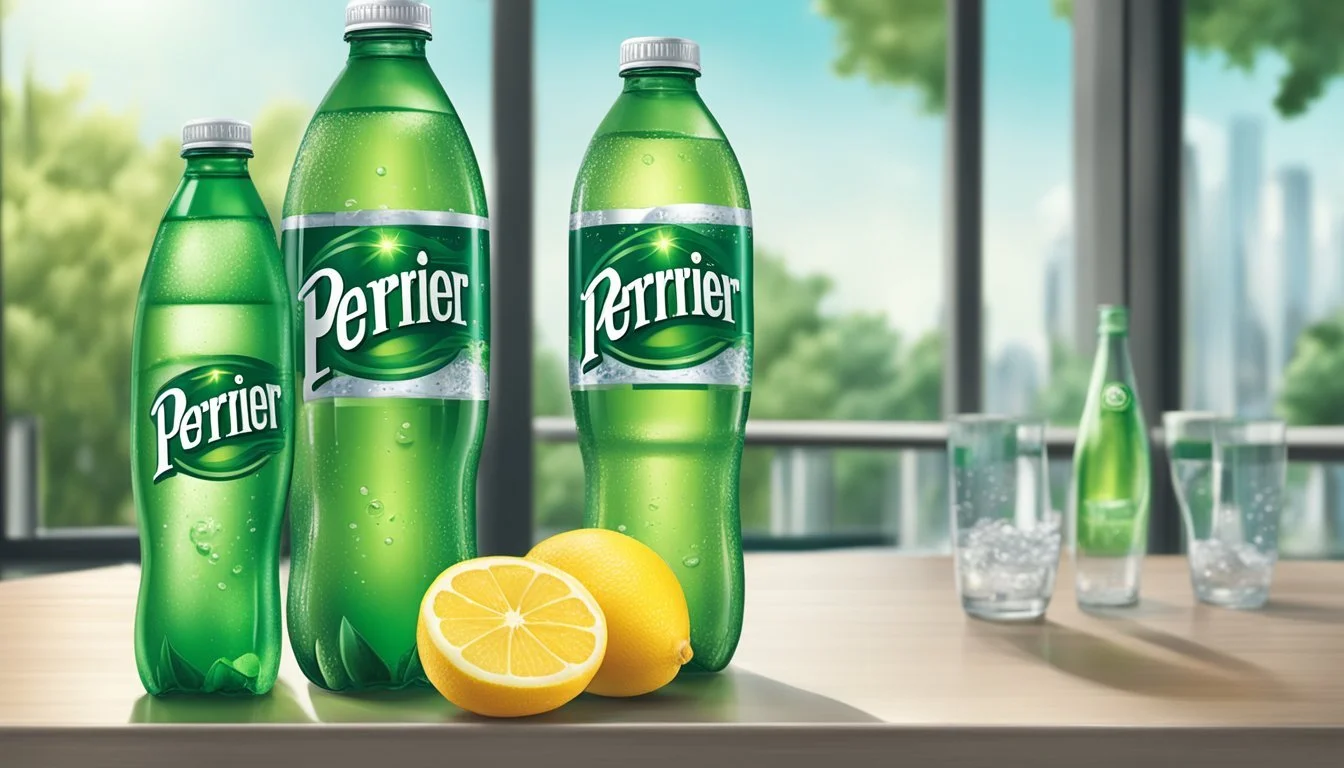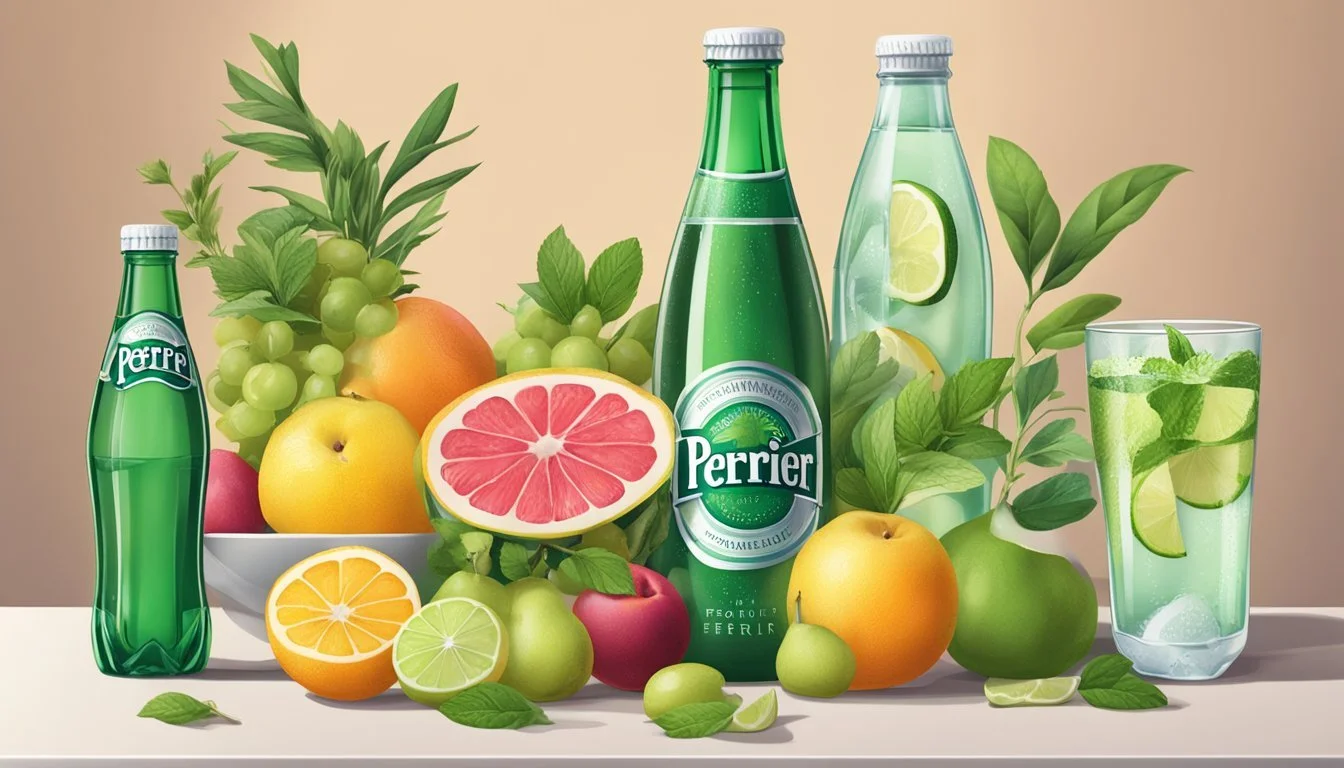Core Hydration vs. Perrier
A Comparative Analysis on Bottled Water Quality
In the ever-growing market of bottled water, consumers are faced with an array of choices that cater to different preferences and needs. Among these, Core Hydration and Perrier have emerged as popular options. Core Hydration prides itself on producing water that is balanced with electrolytes to match the body's natural pH level, ensuring a clean and crisp taste. Its design and marketing are tailored to health-conscious individuals who prioritize proper hydration with an optimal pH balance for their body.
Perrier, on the other hand, is a sparkling mineral water that has distinguished itself with its naturally occurring carbonation and distinctive green bottle. Originating from France, Perrier's unique mineral composition and bubbles have made it a favorite for those seeking a refreshing alternative to still water or sugary beverages. Its taste and effervescence are often enjoyed on their own or used as a mixer in cocktails.
When comparing Core Hydration with Perrier, factors like taste preferences, the benefits of added electrolytes versus natural minerals, and the choice between still and sparkling water come into play. It's essential to look beyond the branding to understand how each water's properties can cater to individual hydration needs and personal tastes.
Overview of Bottled Water
The bottled water industry has seen a significant rise in popularity, offering consumers a variety of water types from different sources such as springs and wells. Consumer preferences and water quality standards have shaped the industry.
The Rise of Bottled Water
Bottled water has become a staple in many households and institutions due to its convenience and the perception of it being a purer alternative to tap water. The demand has escalated over the years, leading to notable distinctions between types of bottled water as well as the emergence of numerous water brands. Factors like taste, mineral content, and the process of purification distinguish bottled water from its tap and well counterparts.
Types of Bottled Water
The market categorizes bottled water primarily by its source and treatment process. Key types include:
Spring Water: Sourced from natural springs, this water is often praised for its freshness and mineral composition.
Mineral Water: Typically originating from a well or spring, mineral water retains a set amount of minerals and trace elements from its source.
Purified Water: Water that has been mechanically filtered or processed to remove impurities and make it suitable for drinking.
Each type of bottled water undergoes a specific regulatory process to ensure safety for consumption. Comparing the mineral content and purification methods becomes essential when analyzing brands like Core Hydration and Perrier, with Core known for electrolyte-enhanced, ultra-purified water, and Perrier as a widely recognized brand of carbonated mineral water.
Core Hydration and Perrier Defined
In the realm of bottled waters, Core Hydration and Perrier stand out for their unique composition and offering. Both brands cater to different preferences but boast qualities like added minerals and distinct pH levels.
What is Core Hydration
Core Hydration is a brand of bottled water that distinguishes itself through a seven stage reverse osmosis purification process. Each bottle is enhanced with electrolytes and minerals and is carefully balanced to a pH of 7.4, aligning closely with the human body's natural pH.
What is Perrier
Perrier is a brand of natural spring water, renowned for its carbonation and the presence of unique minerals. Originating in France, this sparkling water has a low sodium content and offers a crisp taste experience. Perrier's iconic green bottle is synonymous with its natural bubbling mineral content.
Health and Hydration
In comparing Core Hydration and Perrier, it is essential for the reader to understand the health implications and hydration benefits these bottled waters offer. This includes their mineral content and the role of electrolytes in maintaining proper hydration.
Hydration and Its Importance
Hydration is crucial for maintaining bodily functions. Water facilitates nutrients and oxygen to cells, regulates body temperature, and acts as a cushion for joints and organs. Both Core Hydration and Perrier contribute to these hydration needs, albeit with distinct characteristics.
Core Hydration
Core Water is designed to maintain the body's natural pH balance and includes added electrolytes for taste. The electrolytes include sodium, potassium, magnesium, and calcium, which are essential for hydrating efficiently. By providing a balance of electrolytes, Core Hydration can support those individuals, particularly athletes, needing to replenish lost minerals during intense physical activity.
Nutrient Profile:
Sodium: Trace amounts
Potassium: Added for electrolyte balance
Magnesium: Added for electrolyte balance
Calcium: Added for electrolyte balance
Perrier
Perrier, on the other hand, is a type of sparkling mineral water that naturally contains a mix of minerals due to its source. It is particularly low in sodium, which makes it a preferable option for those on a low-sodium diet. Furthermore, its carbonation can provide a refreshing alternative to still water.
Mineral Content:
Sodium: Less than 10mg per liter
Minerals: Naturally occurring, but varies depending on the source
Health Benefits of Drinking Water
Water is a fundamental aspect of a healthy diet. It aids in digestion, waste elimination, and the absorption of nutrients. The health benefits of drinking water are numerous, each brand offers its unique set of advantages based on its mineral content.
Core Hydration
Core Water, being free from calories, sugars, and fluoride, minimizes the risk of dental caries and is compatible with low-calorie diets, making it beneficial for health-conscious individuals.
Perrier
Perrier provides a different array of health benefits due to its mineral content. It may supply trace amounts of beneficial minerals, such as magnesium and calcium. However, consumers should be aware of the potential presence of heavy metals in mineral waters, which, if consumed at high levels, could be detrimental to health. Perrier's mineral levels are regulated, ensuring that they remain within safe consumption limits.
Quality and Purity Analysis
In this section, a thorough analysis of Core Hydration and Perrier bottled waters is conducted, focusing on their filtration processes, mineral content, and contaminant levels to determine which brand offers superior quality and purity.
Filtration and Purification Methods
Core Hydration boasts a purification process that involves ultra-filtration, UV light treatment, and reverse osmosis to reduce impurities and contaminants. Core Hydration also utilizes a 7-stage purification process to achieve its distinctive blend, with the end goal of matching the optimal pH level of the human body, which they claim is 7.4 pH.
Perrier, on the other hand, is a naturally carbonated mineral water sourced from the Vergèze spring in France. Perrier’s filtration process is nature’s own, as the water filters through layers of limestone where it naturally acquires minerals and a light carbonation. While natural filtration processes occur, Perrier does not utilize artificial filtration like reverse osmosis.
Comparing Mineral Content
Core Hydration claims to add electrolytes and minerals post-filtration for taste and balance:
Added minerals/electrolytes: calcium chloride, magnesium chloride, potassium bicarbonate
Perrier has naturally occurring minerals, which contribute to its taste and provide a distinct mineral content:
Mineral Content in Perrier Bicarbonate 430 mg/L Calcium 150 mg/L Chloride 22 mg/L Fluoride 0.5 mg/L Magnesium 4.2 mg/L Sodium 9.5 mg/L Sulphate 33 mg/L TDS (Total Dissolved Solids) ~500 mg/L
Given the natural variation in the mineral content of Perrier, specific levels of minerals like phosphorus, zinc, and manganese may not be standardized, unlike Core Hydration which maintains consistency through its added mineral blend.
Contaminant and Purity Levels
When it comes to purity levels, Core Hydration emphasizes its reverse osmosis filtration technique, which is effective in removing most heavy metals, lead, fluoride, and other contaminants. Core Hydration markets its water as being free from fluoride, chromium 6, MTBE, arsenic, and chlorine.
Perrier’s mineral water, traditionally associated with luxury and high quality, undergoes rigorous testing for purity. It conforms to the European Union standards for mineral water, which implies limited levels of regulated contaminants, including heavy metals, lead, fluoride, and chloride. While there have been no major reports of contamination in Perrier, the presence of minerals suggests that its TDS level is naturally higher than that of Core Hydration, which aims for minimal TDS post-filtration.
Both brands are subject to regular quality testing to ensure they meet the regulatory standards for bottled water in their respective markets.
Nutritional and Ingredient Breakdown
The comparison between Core Hydration and Perrier centers on their nutritional content and ingredient list. This section delves into the electrolyte and mineral content, analyzes the presence of sugars, and examines any vitamin fortification present in these bottled waters.
Electrolyte and Mineral Enhancement
Core Hydration water boasts electrolytes for taste and includes a unique blend of minerals for hydration. Core Water's mineral content is specifically calibrated to match the natural pH of the human body. Perrier, on the other hand, is a sparkling mineral water naturally enhanced with calcium, magnesium, and other minerals.
Mineral Content Comparison
Mineral Core Hydration (per serving) Perrier (per serving) Calcium Not specified Present Magnesium Not specified Present Potassium Not specified Trace amounts
Investigating the Presence of Sugars
Both Core Hydration and Perrier are calorie-free beverages that contain zero sugars. They offer a clean drink without the risk of added sugar or the calories that come with it.
Sugar Content
Brand Sugars (per serving) Core Hydration 0g Perrier 0g
Vitamin Fortification in Water
Neither Core Hydration nor Perrier is vitamin-fortified. Their main selling points are hydration and mineral content rather than serving as a source of vitamins. They do not contain Vitamin A, C, E, or any B-vitamins such as B1, B2, B3, B5, B6, folate, B12, or Vitamin K, which are often added to functional or enhanced waters.
Environmental Impact and Sustainability
When considering the environmental impact and sustainability of bottled water brands like Core Hydration and Perrier, one must examine the processes involved in bottling and the water stewardship efforts of the companies.
Bottling Processes and Environmental Concerns
Both Core Hydration and Perrier are known for their unique bottling processes, but these come with sustainability concerns. The environmental impact of bottled water is significantly higher than tap water, primarily due to the energy consumption, water usage, and waste associated with plastic bottles. Studies indicate that the production of bottled water requires up to three times as much water as the bottle actually holds and that the impact on ecosystems can be up to 1,400 times higher compared to tap water.
For example, the state of California has faced challenges balancing commercial water bottling operations with maintaining local water supplies, especially during periods of drought. Regulatory bodies like the EPA (Environmental Protection Agency) emphasize the importance of assessing and mitigating these issues to protect resources and uphold environmental standards.
Materials Used:
Plastic: Most common material for bottled water, impacts include production and end-of-life waste.
Glass: Alternative used by brands like Perrier; heavier, impacts transportation emissions.
Concerning Figures:
Carbon footprint: Bottled water is associated with higher CO2 emissions compared to tap water.
Recycling rates: A significant portion of plastic bottles are not recycled, contributing to environmental pollution.
Corporate Water Stewardship
In terms of corporate water stewardship, it is important to recognize the efforts made by companies to mitigate their environmental impact. Perrier, for example, has been involved in initiatives to improve its bottling sustainability, unveiling prototypes for new water bottles using innovative recycling technology. The brand also introduced The Next Packaging Movement, aiming to collaboratively develop sustainable packaging solutions.
Core Hydration's parent company, Keurig Dr Pepper, has its corporate social responsibility strategy which includes improving the recyclability of packaging and reducing its carbon footprint. They also stress the importance of sustainable water use and source water protection, crucial for maintaining a favorable environmental standing.
Stewardship Efforts:
Sustainable packaging: Exploring innovative approaches to create less impactful bottled water packaging.
Water source protection: Initiatives to protect and sustain the water sources that supply bottled water.
Each brand's approach reflects efforts toward greater sustainability in their respective industries. It is essential for consumers to consider these aspects when making purchasing decisions.
Taste and Consumer Preference
When comparing Core Hydration and Perrier, one must consider the unique taste profiles influenced by mineral content and processing, alongside how marketing shapes consumer preferences.
Factors Influencing Taste
Core Hydration prides itself on its ultra-purified water, boasting a balanced pH and enhanced with minerals and electrolytes. This process aims to deliver a clean, crisp taste intended to complement a health-conscious lifestyle. The added electrolytes can slightly alter the taste, making it refreshing to some palates, especially after physical activity.
Perrier, on the other hand, is a sparkling mineral water that sources its contents from a spring in Vergèze, France. The natural occurrence of carbonation and minerals define Perrier's taste. It's known for a sharp, effervescent kick, with subtle nuances from its unique mineral blend.
Core Hydration Perrier Type of Water Purified with added electrolytes Natural sparkling mineral water Taste Profile Clean, crisp, with a smooth finish Sharp, effervescent, subtly complex Aftertaste Neutral Distinguishing dryness Ideal Consumption Situations Gym, office, on-the-go Fine dining, celebrations
Public Perception and Marketing
The public's perception of bottled water is heavily influenced by marketing strategies. Core Hydration's branding aligns with the lifestyle of health and wellness enthusiasts, positioning itself as an integral part of an active day. Its marketing materials often feature athletes and fitness influencers, suggesting that their product is tailored for a performance-oriented consumer.
Perrier has carved out a different niche; its branding leans towards the luxurious and sophisticated. Its iconic green bottle and association with high-end events and locales suggest a more upscale, indulgent experience. This has influenced consumers to associate Perrier with a chic lifestyle and has made it a popular choice in the context of social beverages.
Each brand's marketing efforts shape consumer taste expectations even before the first sip, with Core Hydration being seen as a utility hydrator and Perrier viewed as a statement drink.
Price Point and Market Comparison
In this comparison of Core Hydration and Perrier, price point and market presence are significant factors for consumers making purchasing decisions. The affordability and widespread availability of bottled water brands can influence their popularity and consumer preference.
Affordability and Accessibility
Core Hydration typically offers a more accessible price point and is often found at a variety of retail locations, making it a practical choice for everyday hydration. A gallon of Core Hydration can be found for around $1.29, situating it on the more affordable end of the spectrum.
On the other hand, Perrier is marketed as a premium sparkling mineral water and is priced higher than Core Hydration, reflecting its positioning as a luxury brand. It's not uncommon for Perrier to be sold in smaller quantities, often in glass bottles or slim cans that cater to a different consumption experience.
Comparing other brands, Fiji and Evian are akin to Perrier in their premium market segment, often priced higher due to their exotic sourcing and brand prestige. At the opposite end, Aquafina and Dasani, backed by soft-drink giants PepsiCo and Coca-Cola respectively, are more akin to Core Hydration in terms of affordability and are widely available.
Comparative Analysis of Water Brands
When examining comparative market presence, Perrier's unique positioning as a carbonated beverage distinguishes it from still water brands, including Core Hydration. The effervescent quality of Perrier might situate it closer to club sodas and sparkling waters, such as San Pellegrino and LaCroix.
Still water brands such as Deer Park, Nestlé Pure Life, Arrowhead, and Ice Mountain are competing with Core Hydration for shelf space, with price points and regional brand recognition playing pivotal roles. Smartwater and Voss, like Perrier, tend to appeal to a more upscale market segment and are priced accordingly.
In a head-to-head comparison, Core Hydration offers a more competitive price and broader accessibility than Perrier, appealing to a budget-conscious demographic. However, Perrier enjoys a unique space in the market due to its carbonation and long-standing reputation for luxury, which justifies its higher price point and selective distribution.
The market for bottled water is diverse, with numerous competitors like Icelandic Glacial, Acqua Panna, and VOSS offering different value propositions, from purity and mineral content to packaging aesthetics. Each brand carves out its niche based on these attributes alongside their price and market presence, catering to a variety of consumer preferences.
Final Assessment
In this section, the intrinsic properties and benefits of Core Hydration and Perrier bottled waters are evaluated, with a focus on their nutritional profiles and suitability for various consumer preferences.
Summary of Core Hydration vs. Perrier
Core Hydration is marketed as ultra-purified water, enriched with a unique blend of electrolytes and minerals. This product prides itself on its seven-step purification process which includes reverse osmosis and ultraviolet light treatment designed to remove impurities and enhance taste. Core Hydration aims to provide optimal hydration with a clean taste.
Perrier, on the other hand, is a naturally carbonated mineral water, sourced in the south of France. Its sparkling quality and distinct taste is due to the unique blend of minerals and carbonation. Perrier is often consumed as a refreshing beverage, a cocktail mixer, or as a palate cleanser.
Recommendations and Personal Preference
When choosing between Core Hydration and Perrier, consumers should consider the following:
Hydration Needs: Core Hydration may be preferable for those seeking water with added electrolytes for rehydration purposes.
Taste and Texture Preferences: For individuals who enjoy effervescence, Perrier offers a bubbly alternative with a sharp, refreshing taste.
Dietary Considerations: People monitoring their sodium intake might prefer Core Hydration which contains no added sodium.
In terms of personal preference, it ultimately depends on one's liking for still or sparkling water and any specific health or dietary considerations they might have. Consumers are advised to try both and determine which product suits their individual tastes and hydration needs.






